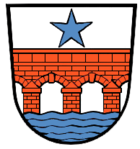Our location: Am Mainkai

 History History
Heidenfeld may have arisen during the Frankish taking of the land in the early 8th century. Already by 855 the place belonged to the Holzkirchen Monastery, which from this time belonged to the Fulda Abbey. The Counts of Wertheim, who were the monastery’s Vögte also managed in the late 13th century to secure the same office over Heidenfeld. In 1397, Marktheidenfeld was first described as a town. Between 1522 and 1530, the Reformation was introduced into the County of Wertheim, and thereby also into Marktheidenfeld. In 1612, after the Würzburg-Wertheim Feud (1599 to 1617), Heidenfeld was taken over as a Würzburg fief, and thus began the Counterreformation under the clergyman Johannes Molitor (1576–1639). From 1632 to 1634, after the Swedes’ victories in the Thirty Years' War, the town was once again Protestant, albeit for only a short time, for the town soon passed to the Princely Electorate (Hochstift) of Würzburg. In 1649, the name Marktheidenfeld made its first appearance, to distinguish the town from the Heidenfeld Monastery near Schweinfurt, which likewise belonged to Würzburg. The Amt of the Princely Electorate (Hochstift) of Würzburg was in Bavaria’s favour secularized in 1803, and then ceded in a border adjustment treaty in 1807 to the Grand Duchy of Würzburg, with which it passed in 1814 to Bavaria. In 1814, Marktheidenfeld became the seat of the Homburg district court, forerunner of the Marktheidenfeld Bezirksamt (a local authority), which in 1939 took the name Landratsamt (district head’s office). In 1948, Marktheidenfeld, which underwent a great upswing in population growth after the Second World War with the arrival of Heimatvertriebene, was raised to town. In 1972, the Marktheidenfeld district (Landkreis Marktheidenfeld) was abolished. Since the municipal reforms in Bavaria (1972–1976), the formerly self-administering communities of Altfeld, Glasofen, Marienbrunn, Michelrieth, Oberwittbach and Zimmern have belonged to Marktheidenfeld.

Quelle:www.wickipedia.org
|
|

